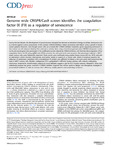Mostrar o rexistro simple do ítem
Genome Wide CRISPR/Cas9 Screen Identifies the Coagulation Factor IX (F9) as a Regulator of Senescence
| dc.contributor.author | Carpintero-Fernández, Paula | |
| dc.contributor.author | Borghesan, Michela | |
| dc.contributor.author | Eleftheriadou, Olga | |
| dc.contributor.author | Pan-Castillo, Belén | |
| dc.contributor.author | Fafián Labora, Juan Antonio | |
| dc.contributor.author | Mitchell, Tom P. | |
| dc.contributor.author | Yuste, Alejandro | |
| dc.contributor.author | Ogrunc, Muge | |
| dc.contributor.author | Nightingale, Thomas D. | |
| dc.contributor.author | Mayán, María | |
| dc.contributor.author | O'Loghlen, Ana | |
| dc.date.accessioned | 2022-03-02T08:31:56Z | |
| dc.date.available | 2022-03-02T08:31:56Z | |
| dc.date.issued | 2022-02-19 | |
| dc.identifier.citation | Carpintero-Fernández, P., Borghesan, M., Eleftheriadou, O. et al. Genome wide CRISPR/Cas9 screen identifies the coagulation factor IX (F9) as a regulator of senescence. Cell Death Dis 13, 163 (2022). https://doi.org/10.1038/s41419-022-04569-3 | es_ES |
| dc.identifier.issn | 2041-4889 | |
| dc.identifier.uri | http://hdl.handle.net/2183/29856 | |
| dc.description.abstract | [Abstract] During this last decade, the development of prosenescence therapies has become an attractive strategy as cellular senescence acts as a barrier against tumour progression. In this context, CDK4/6 inhibitors induce senescence and reduce tumour growth in breast cancer patients. However, even though cancer cells are arrested after CDK4/6 inhibitor treatment, genes regulating senescence in this context are still unknown limiting their antitumour activity. Here, using a functional genome-wide CRISPR/Cas9 genetic screen we found several genes that participate in the proliferation arrest induced by CDK4/6 inhibitors. We find that downregulation of the coagulation factor IX (F9) using sgRNA and shRNA prevents the cell cycle arrest and senescent-like phenotype induced in MCF7 breast tumour cells upon Palbociclib treatment. These results were confirmed using another breast cancer cell line, T47D, and with an alternative CDK4/6 inhibitor, Abemaciclib, and further tested in a panel of 22 cancer cells. While F9 knockout prevents the induction of senescence, treatment with a recombinant F9 protein was sufficient to induce a cell cycle arrest and senescence-like state in MCF7 tumour cells. Besides, endogenous F9 is upregulated in different human primary cells cultures undergoing senescence. Importantly, bioinformatics analysis of cancer datasets suggest a role for F9 in human tumours. Altogether, these data collectively propose key genes involved in CDK4/6 inhibitor response that will be useful to design new therapeutic strategies in personalised medicine in order to increase their efficiency, stratify patients and avoid drug resistance. | es_ES |
| dc.description.sponsorship | This paper was funded by the BBSRC (BB/P000223/1), the MRC (MR/K501372/1), The Royal Society (RG170399) and Barts Charity (MGU0497 and G-002158) grants to A.O. M.M. was funded by PI19/00145, IN607B2020/12 and 858014. J.F.L. is funded by Xunta de Galicia (ED481B 2017/117). M.B. was funded by MRC (MR/K501372/1). T.P.M. was funded by a QMUL PhD programme and T.D.N.’s lab is currently funded by a Barts Charity project grant (MGU0534). P.C.F. is currently funded by GAIN (IN606C 2021/006) Xunta de Galicia | |
| dc.description.sponsorship | Reino Unido. Biotechnology and Biological Sciences Research Council; BB/P000223/1 | |
| dc.description.sponsorship | Reino Unido. Medical Research Council; MR/K501372/1 | |
| dc.description.sponsorship | Reino Unido. Royal Society; RG170399 | |
| dc.description.sponsorship | Barts Charity (Londres); MGU0497 | |
| dc.description.sponsorship | Barts Charity (Londres); G-002158 | |
| dc.description.sponsorship | Xunta de Galicia; IN607B2020/12 | |
| dc.description.sponsorship | Xunta de Galicia; ED481B 2017/117 | |
| dc.description.sponsorship | Barts Charity (Londres); MGU0534 | |
| dc.description.sponsorship | Xunta de Galicia; IN606C 2021/006 | |
| dc.language.iso | eng | es_ES |
| dc.publisher | Nature | es_ES |
| dc.relation | info:eu-repo/grantAgreement/ISCIII/Plan Estatal de Investigación Científica y Técnica y de Innovación 2017-2020/PI19%2F00145/ES/FARMACOS DE NUEVA GENERACION BASADOS EN COMPUESTOS PEPTIDOMIMETICOS MODULADORES DE LAS CONEXINAS COMO AGENTES TERAPEUTICOS PARA RESTAURAR LA REGENERACION TISULAR EN PIEL Y CARTILAGO ARTICULAR/ | |
| dc.relation | info:eu-repo/grantAgreement/EC/H2020/858014 | |
| dc.relation.uri | https://doi.org/10.1038/s41419-022-04569-3 | es_ES |
| dc.rights | Creative Commons Attribution 4.0 International License (CC-BY 4.0) | es_ES |
| dc.rights.uri | http://creativecommons.org/licenses/by/4.0/ | * |
| dc.subject | Senescence | |
| dc.subject | Tumour biomarkers | |
| dc.title | Genome Wide CRISPR/Cas9 Screen Identifies the Coagulation Factor IX (F9) as a Regulator of Senescence | es_ES |
| dc.type | info:eu-repo/semantics/article | es_ES |
| dc.rights.access | info:eu-repo/semantics/openAccess | es_ES |
| UDC.journalTitle | Cell Death and Disease | es_ES |
| UDC.volume | 13 | es_ES |
| UDC.issue | 2 | es_ES |
| UDC.startPage | 163 | es_ES |
| dc.identifier.doi | 10.1038/s41419-022-04569-3 |
Ficheiros no ítem
Este ítem aparece na(s) seguinte(s) colección(s)
-
OpenAIRE [288]
-
GI-TCMR - Artigos [128]
-
INIBIC-TCMR - Artigos [102]







